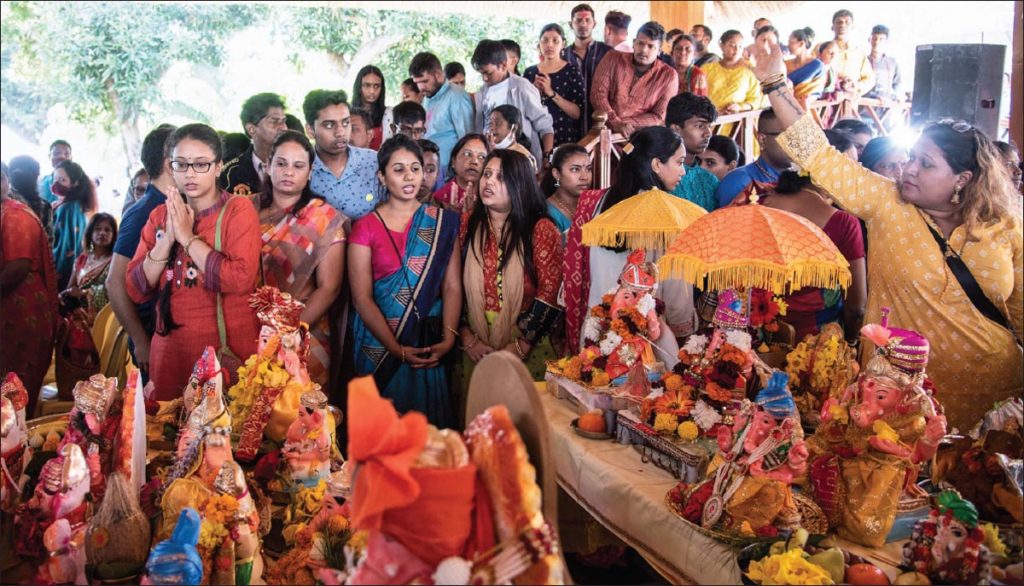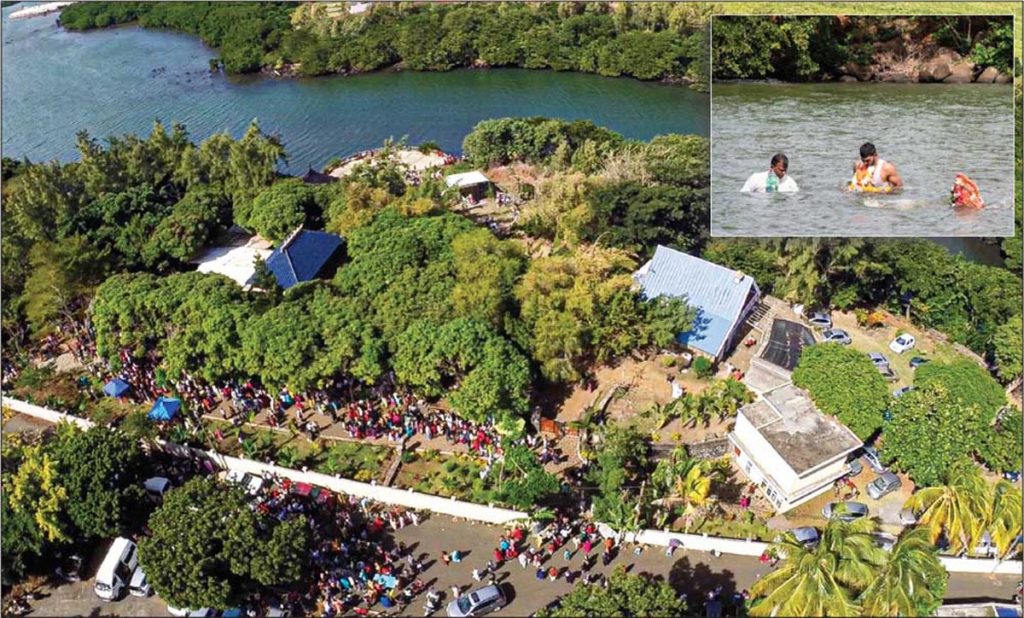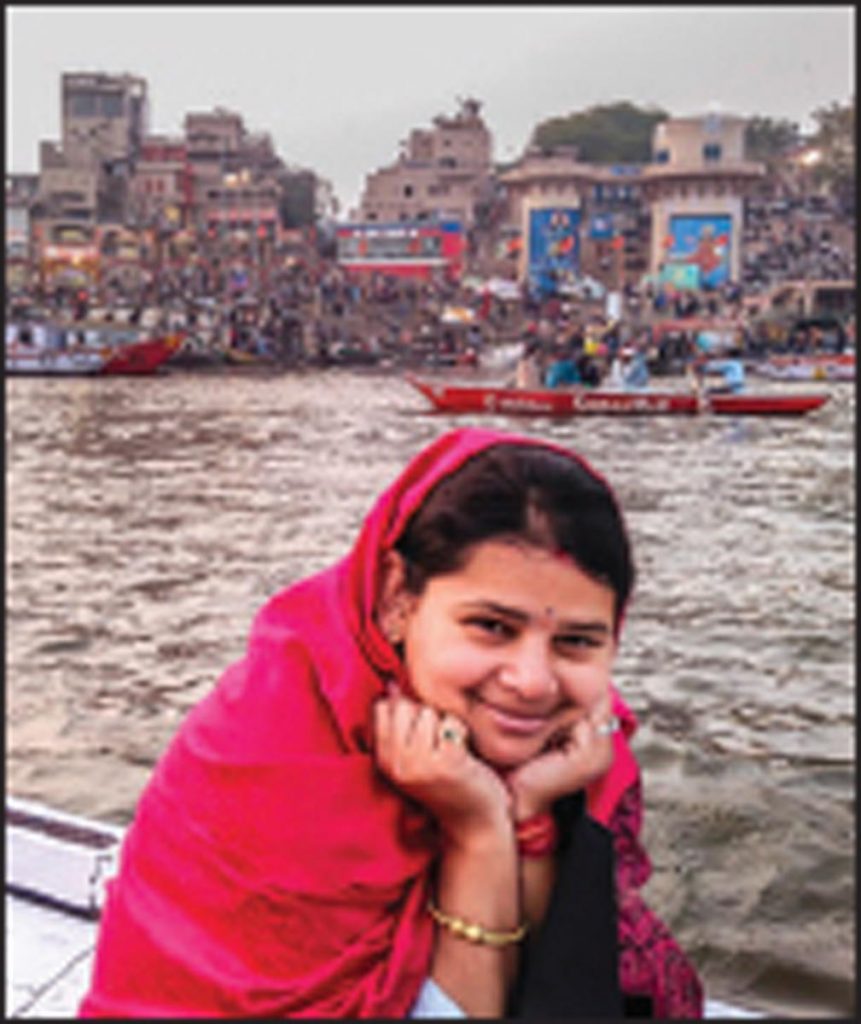Come with us to the Spiritual Park in Mauritius, where thousands gather for Ganesha Chaturthi—hopefully with the worst of the pandemic behind them
By Savita Tiwari, Mauritius
Mauritius: a land of sandy beaches, turquoise water, clean blue sky and breathtaking landscapes. This small country, located in the Indian Ocean off the coast of Africa, is a place where Hinduism, the majority religion, stands proudly, people are friendly and religious and every Hindu festival is a national celebration. Ganesha Chaturthi is the biggest festival here, attracting in particular thousands each year to the Spiritual Park, where the Rempart River meets the ocean, to worship the elephant-faced God on His birthday.
As of July 23, 2020, the day of the festival, the Covid-19 pandemic has barely touched us. Currently there are only two active cases on the island, both related to travel. Large crowds are once again allowed to gather without masks or social distancing.
I know parking spaces will be scarce, so I take a taxi for the 25-mile journey from home. For me, that’s a long trip—our island is just 40 miles north to south and 30 miles wide. There are many temples closer to home, but this is an opportunity for a mini-pilgrimage. Passing through our beautiful landscape of mountains, villages and sugarcane fields, I see dozens of temples celebrating the festival. Banners are hung on every roundabout, and every available wall is plastered with posters announcing the festival’s celebration by various associations and temples.

As I approach the park, I can start to feel the difference. Still a mile out, traffic has slowed to a crawl. One lane is completely dedicated for devotees to park their cars and walk to the site. All wear colorful traditional Hindu attire: women in saris and churidars; girls in lehengas; men and boys in kurta pajama outfits. Some shop along the way at the colorful stalls lining the road, where vendors are selling everything from puja offerings and souvenirs to hats and books—anything one can think of to buy at a fair. Everything is sparkling with tradition and festival.
In the small, secluded village of Pointe de Lascar, police are directing traffic at the final turn, on to the aptly-named Ganesha Lane. My taxi is allowed no farther. Loudspeakers bring me the priestly chanting of mantras as I walk the last 100 yards past more vendor stalls. Arriving devotees are buying fruits and other offerings to supplement their prayer platters; those departing after their darshan are buying things for their happy kids. It is around 9am; the earlier showers have stopped and the sun is out, making it a very fresh tropical morning.
The three-acre Spiritual Park, opened to the public in 1999, contains several shrines. The focus today is on the largest, a Kerala-style building housing an eight-foot-tall granite Panchamukha Ganapati, the five-faced form of Lord Ganesha. Conceived by Satguru Sivaya Subramuniyaswami (founder of HINDUISM TODAY), the park is a branch of Saiva Siddhanta Church, Hawaii, USA.
The devotees’ loving effort is evident in their prayer platters. Handmade modakas (reputed to be Ganesha’s favorite sweet) along with fruits, flowers and the sacred doob grass surround the centerpiece of each platter, a small murti of Ganesha made of clay, sand, even raw tumeric. I ask one lady about hers. “Oh, I made it with the help of a YouTube video,” she said proudly. “It was tricky but still we managed. Isn’t it beautiful? We let it dry for a day and colored it with my kids’ watercolors. It’s the tradition here to make or buy a murti, pray to Him at home, then bring Him here. All the murtis are kept in front of the Panchamukha Ganesha during the prayer rituals. Then we carry our murtis in procession to the river for the immersion ceremony.”
This is indeed a park—a walled garden, really—with trees, benches, unspoiled nature, fruit trees and flowering plants. Birds sing in harmony despite humans everywhere. Even the small wooden bridges give one a feeling of nature. A salty breeze announces the nearby sea. A few people, fortunate enough to find a peaceful corner, are sitting in deep meditation. Others of all ages are in full festival mode with a broad smile on their face, greeting all who cross their path, praying, mingling, eating prasad, lighting lamps—a complete dose of the joyful spirit of the day.
The main Panchamukha Ganapati mandapam is nothing like the hurricane-proof concrete temple construction common in Mauritius. Built in the Kerala style, it is a large open-sided ornate wooden building with a blue tile roof. On the central platform stands a magnificently adorned eight-foot-tall black granite Panchmukha Ganapati. Thousands of devotees are seated around the mandapam, so I bow from a distance, still easily feeling the connection, the vibrations, the blessings.
Priests are performing fire worship and related rituals at a big havan kund in front of Panchamukha Ganapati. Tables hold the murtis brought by devotees. On the far side, devotees with musical instruments are conducting bhajan.
Touring the Park
I meet the person who invited me and am handed over to a friendly lady, Magadevi Canagasaby, for a tour of the place. “Opposite the entrance there is a small store, the Minimela, where we sell publications of the park’s founder,” she explains. “Scattered throughout the park are the rest of Ganesha’s family in small, beautifully carved wooden structures. Across from the main mandapam is a set of stairs down to a landing by the sea.”
A lady named Premila is volunteering in the Minimela. I ask if she is not missing the puja. “Not at all,” she says. “At the moment my service to Lord Ganesha is to offer the knowledge to as many people as possible through books.” I ask how long she has been associated with the Spiritual Park. “It’s a long story,” she says. “But since I was 12, I was looking for a guru who could answer my questions about dharma and life. When I was 18, I got my answers in an editorial of Sivaneri magazine, published by Himalayan Academy here in Mauritius. Since then I am at the feet of Ganesha. I met my husband here; my kids grew up coming to Ganesha. Before that, we didn’t know where our lives were taking us. We were doing puja and all, but we didn’t know the meaning and philosophy behind the rituals. The books we sell here help people answer their questions just like they did for me.”

I next visit a separate small shrine with a three-foot Ganesha murti. Here people can make their offerings and do their prayers when a big event is being held in the larger temple. Nearby, people are lighting earthen lamps at a beautiful wrought-iron lamp tree while chanting Gam Ganpataye Namaha and other Sanskrit mantras. Mauritians are a very spiritual and knowledge-acquiring people, particularly adept at learning mantras.
I ask Magadevi if I might have a small chat with the priest to talk about the rituals. She replies, “We don’t have priests here. At the Spiritual Park, everyone who comes prays on their own. We only hire priests for special occasions such as this.” I fall in love with this concept: “praying on your own.” No one between you and your God. As the wife of a priest, I understand the importance of a priest for a temple, but I also understand when a devotee should be left alone.
I ask why the consort of Siva is not given a place in the park. Magadevi explains, “We don’t see Siva and Shakti as two people. For us, they are one.”
At the Dakshinamurti Mandapam—Siva as the silent guru—I find people praying with closed eyes, offering flowers and incense. And at the furthest part of the park we encounter Lord Murugan, Ganesha’s younger brother, sitting facing the ocean.
At the railing here, where one can see the confluence of the river and the sea, a young girl is standing alone, deep in thought. Although I normally leave people alone, I was inclined to ask what she was thinking. “Nothing,” she answers, “I am just seeing how the river leaves its identity and merges with the ocean. Today my journey started with the prayer at Panchamukha Ganesha. From there I went to the waterfront and sat watching the serene river. Next I walked to Dakshinamurti and meditated for a few minutes, then to Murugan. I have traveled the whole park like a river. Standing facing the ocean, I feel I have completed my journey as a river. On this pious day of Ganesha Chaturthi, I am ready to leave my ego, my anger and my regrets, ready to be my true self. Ready to merge with the Supreme Being, just like the river is merging with the ocean.” Remarkable insights indeed from one so young.
I am next introduced to Kamayshvaran Vythelingum, an active youth volunteer at the Spiritual Park. I inquire about his journey to Ganesha. “My brother bought me here for the first time seven years back. Since then Ganesha is part of my life. We have started classes on the Path to Siva book. Anyone is free to join these classes, but unfortunately, only ten people are attending.” He seems dispirited, so I encourage him: “Don’t worry. The Gita was told by one person to just one person. The number of people is not the point when it comes to knowledge.” Uplifted, he continues: “I think spirituality is an integral part of human character. Spirituality is not only rituals and volunteering, it is finding peace. The Spiritual Park is not a temple for me. It’s a place where anyone from any religion can come and find peace within nature. Though it is embedded into Hinduism, the philosophy is universal. Due to the Internet, Western culture is influencing youth more and more. We are still trying to find our own identity. In Mauritius youth are now coming to accept that they must have Hinduism as part of their life.”
I meet another youth, Arinien Mootoocurpen, an aspiring actor with an optimistic point of view. Before entering university, he completed a six-month work/study program at Kauai’s Hindu Monastery in Hawaii, the headquarters of the park’s founder, where he lived the life of a monk. Asked about Mauritian youth, he replies, “We are very spiritual by nature. We are inclined toward other cultures, because we want to learn new things. Though we wear pants, we also wear traditional kurta shirt. So we are kind of balanced.” He points out the existence of a youth wing in every temple on the island. “Today every temple has its youth team who serve as volunteers during festivals. They take part in bhajans, they serve prasad, they clean the temple. This would not be possible if Mauritian youth weren’t spiritual by nature. It is OK if we wear Western clothes and have parties with friends, but we do happily come to the temple with family in traditional attire.”
Next I am introduced to the oldest member here: Manogaren Mardemootoo, a senior attorney who has seen 70-plus years of life. He has been associated with the Spiritual Park for 40 years. When I ask if he is the oldest member, he replies, “Oldest member alive. Many others played an important role to make this place what it is today, but are not among us anymore. I worked as a youth among them.” He tells us the background story of how in the eighties Subramuniyaswami had a vision of Ganesha here and decided to establish a center. Mardemootoo was instrumental in getting the Saiva Siddhanta Church Act passed in parliament to allow the park’s development [see bit.ly/spiritualpark].
Mardemootoo explains how the Ganesha Chaturthi festival has evolved here over the years. “Earlier we were giving free food to all the devotees who participated. First, it was 50 people, then after a few years, it reached 1,500. It was hard to handle that. We stopped feeding and concentrated just on prayers. Then people started feeding devotees outside the park. And then came the vendors and fruit sellers. Gradually it took the shape of a grand fair spread around more than one mile of distance with tens of thousands of devotees participating from all corners of the island. And the center of all this is the magnificent eight-foot-tall Ganesha standing in His shrine.”
Mardemootoo walks back to the Minimela store with me to sit and chat awhile longer. Everyone along the way greets him with folded hands and a very respectful smile. I ask how he manages to keep inspiring all these people around him. He replies, “We follow the rules which we want others to follow. All the members of the organizing committee, we all wear traditional clothes. Men wear dhoti kurta and women wear saris. People don’t do what you say, they do what you do. It’s a simple rule. We are proud of what we are. Hinduism is a very beautiful way of life. And it starts with Ganesha here.”

Immersion Procession
Rituals concluded, everyone retrieves their Ganesha murti for the Visarjana immersion ceremony. Just as the procession starts, a group of boys in black t-shirts appear with big drums and start playing ferociously. The energy in the air increases by a hundred percent. Everyone is clapping, and some are dancing with their Ganesha murti on their head. After proceding around the park for over an hour, we turn towards the stairs leading down to the waterfront.
Everyone gathers at the half-circle waterfront. A dozen men line up in the water, and people start passing their Ganesha murtis to them. They stand waist deep with Ganesha sitting happily on their head while people do arati from the shore. As soon as arati is done, all those in the river take three dips with the Ganesha, leaving Him submerged the third time. In this way all the Ganesha murtis are immersed, with a promise to come back soon again next year.
I am sitting on the stairs watching the ceremony. A few soaked people who already participated in the immersion come and sit on the stairs to dry off. I smile and introduce myself to one youth, asking what he has learned from the Ganesha Chaturthi festival. He introduces himself as Bhavish, a University of Mauritius student. “I never focused on if I should take any lesson from this festival. I just celebrated it. It was fun together with family and friends. But this past month I had a breakup with my longtime girlfriend. It happened due to long distance during the Covid-19 lockdown. I was very disturbed. But today while doing Visarjana I felt that this festival teaches us to ‘let go.’ We pray to Ganesha all day long, we fall in love with Him, we celebrate His presence in our lives and now we just have to immerse Him in the water. We can keep the murti for a day or five or even ten days but we can’t keep Him more than that. On Ananta Chaturdasi we have to do Visarjana, as the next day is the start of Pitra Paksha (honoring of ancestors). So it taught me to let go of things. Nothing is permanent in life. We have to move on. This thought just crossed my mind while doing the immersion today, and I am feeling very light now. I can move on with my life without regrets.”
As the sun sets, I stand and take in the continuing celebration. People are still dancing, immersion still going on. I return to the main mandapam, where the beautiful black stone five-faced Panchamukha Ganesha of the Spiritual Park is still standing with a smile. I bow before Him one last time, with a promise to return soon.
While coming here in the morning, I wondered why I was traveling so far. But during the ride back home, I am already planning my next trip to the Spiritual Park, where spirituality is in the air.
About the Author

Savita Tiwari grew up in India and is now a resident of Mauritius. She is an avid journalist, blogger, writer and poet with a love of dharma and a penchant for learning more about Hinduism.
